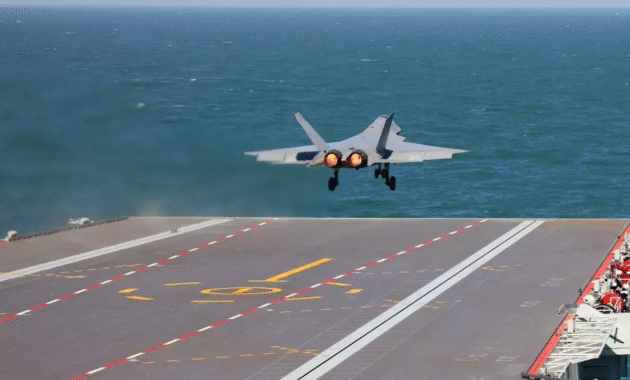webhostdiy.com – Hey, tech nerds and military buffs, buckle up! China just pulled off something massive with its latest aircraft carrier, Fujian. For the first time ever, they’ve successfully launched fighter jets using a cutting-edge electromagnetic catapult system—yep, we’re talking about the Electromagnetic Aircraft Launch System (EMALS). This is a game-changer, folks, and it’s got the world buzzing. Let’s dive into why this is such a big deal and what it means for naval warfare, all while keeping it chill and easy to digest for our webhostdiy.com crew.

From Ski-Jumps to Sci-Fi: What’s EMALS?
So, what’s the fuss about EMALS? Picture this: older Chinese carriers like Liaoning and Shandong used a ski-jump ramp to get planes airborne. It’s like giving jets a sloped runway to leap off, but it’s got limits. Only lightweight planes with serious engine power could handle it. EMALS, though? It’s like something out of a sci-fi flick. This electromagnetic catapult slings planes off the deck with precision and power, letting Fujian launch heavier beasts like fighter jets, early-warning aircraft (AWACS), drones, and even chunky transport planes.
Why’s this cool? Unlike the old-school steam catapults or ski-jumps, EMALS is smoother, more efficient, and can handle a wider range of aircraft. It’s the gold standard for modern carriers, and right now, only one other ship in the world rocks this tech: the U.S. Navy’s USS Gerald R. Ford, which got its EMALS certification in 2022. China joining this exclusive club is a flex, no doubt.
Fujian Shows Off: Jets, Drones, and More
The Chinese military dropped some slick footage recently, showing off their Fujian in action. We’re talking Shenyang J-15T and J-35 fighter jets, plus the Xi’an KJ-600 early-warning plane, all zooming off the deck thanks to EMALS. The videos didn’t just show takeoffs—landings went smooth as butter, too, with the carrier’s arrestor system catching planes like a pro. This isn’t just a tech demo; it’s proof that Fujian’s deck ops are tight, with the catapult and arrestor systems working in sync.
The KJ-600 is a big deal here. This bad boy couldn’t even fly off the older ski-jump carriers because of its weight. With EMALS, Fujian can now handle these heavy hitters, giving China’s navy a serious boost in flexibility. The People’s Liberation Army (PLA) says this test marks Fujian hitting “preliminary full-deck operational capability.” In plain English? The carrier’s deck is ready to rock, and the ship’s getting closer to being fully battle-ready.
Fujian’s Journey: Testing the Waters
Fujian has been out at sea since May 2024, putting its systems through the wringer. It’s cruised through the Taiwan Strait and flexed its muscles in the South China Sea. While China’s keeping mum on exact dates for these EMALS tests, the timing’s no accident. The footage dropped right after a big military parade in Beijing, where the J-15T, J-35, and KJ-600 showed up in a flashy air formation. Coincidence? Nah, this is China saying, “Look at what we’ve got.”
Military analyst Carl Schuster, a former U.S. Navy captain, weighed in, saying Fujian could be officially joining China’s navy in just weeks. “The successful EMALS tests, including launches and landings, mean this ship is about to become a full-fledged part of the fleet,” he told CNN. That’s huge for China, which is rapidly leveling up its naval game.
Why This Matters: Power and Challenges
So, why should you care? For one, EMALS gives Fujian a serious edge. It can launch planes faster, carry a wider variety of aircraft, and project power farther. This isn’t just about flexing in the South China Sea—it’s about China signaling to the world that its navy is a force to be reckoned with. From the Indo-Pacific to beyond, this tech boosts China’s ability to operate far from home.
But it’s not all smooth sailing. EMALS is a beast of a system—super complex and a maintenance nightmare. China’s navy will need top-notch training to keep it running without hiccups. Plus, there’s the geopolitical shade. Neighbors in the Indo-Pacific, already on edge about China’s growing military, might not be thrilled about Fujian’s new tricks. Tensions in the region could heat up as this carrier starts flexing its muscles.
China vs. the World: The EMALS Club
Right now, the EMALS club is exclusive: just China’s Fujian and the U.S.’s Gerald R. Ford. This puts China in rare company, but it also highlights the gap. The U.S. has been perfecting carrier ops for decades, while China’s still catching up. That said, Fujian’s success shows they’re closing that gap fast. With three carriers now (Liaoning, Shandong, and Fujian), China’s navy is no joke, and EMALS puts them on the cutting edge.
kunjungi laman berita Exposenews.id
With these tests in the bag, Fujian is likely gearing up for its official debut in China’s naval fleet. The ship’s been spotted in high-stakes areas like the Taiwan Strait, so expect it to play a big role in China’s regional strategy. Whether it’s flexing during exercises or projecting power in disputed waters, Fujian is about to make waves—literally and figuratively.
For us at webhostdiy.com, this is a reminder that tech isn’t just about websites and servers—it’s transforming everything, from cloud computing to aircraft carriers. China’s EMALS breakthrough is a wild mix of engineering and ambition, and it’s got us hyped to see what’s next. Will other navies jump on the EMALS train? Will China keep pushing the boundaries of naval tech? Stay tuned, because this story’s just getting started.
Keep it locked on webhostdiy.com for more tech-meets-world updates!




